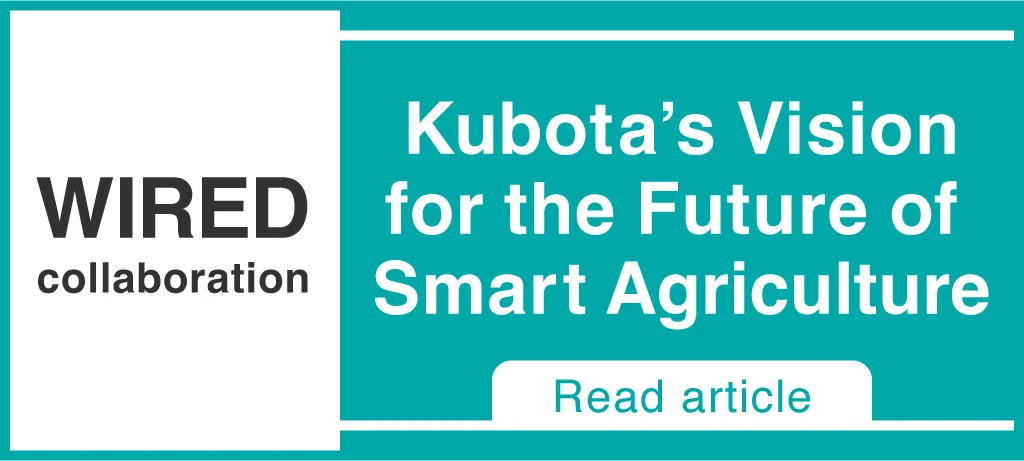For a Future Where Life Continues to Shine Envisioning a Planetary-conscious Agriculture That Is Friendly to the Earth and to People
The fact is that the future of the Earth is at stake.
Are you familiar with the term planetary boundaries?
These are boundaries that must not be crossed if we are to continue to live on the Earth in the future.
A total of nine planetary boundaries have been identified, including “climate change” caused by increasing atmospheric concentrations of greenhouse gases such as carbon dioxide (CO2), “biogeochemical flows” of key elements such as nitrogen and phosphorus caused by the excessive use of fertilizers on farmland, and “biosphere integrity” in which the destruction of virgin forests leads declines in biodiversity and loss of ecological balance.
The latest research indicates that planetary boundaries have already been crossed in six of these areas.
* “Earth beyond six of nine planetary boundaries,” Science Advances (2023)
The causes of this problem have been with us throughout human history.
Since the Industrial Revolution in the second half of the 18th century, industry has continued to develop rapidly using fossil fuels as a primary energy source, and this has led to the emission of increasing amounts of CO2, a major greenhouse gas, into the atmosphere.
In addition, the progressive development of residential and agricultural land as a consequence of population growth has driven deforestation, which has resulted in a major imbalance in the CO2 cycle.
On top of this, in the course of our industrial activities, we have continued to emit pollutants other than CO2 without restraint.
The complex interaction of the above factors has had a devastating effect on soils and ecosystems.
Perhaps the root of the problem lies in a society that has continued to pursue prosperity solely for human beings.
Is there anything agriculture can do?
The deterioration of the global environment has a direct impact on the agricultural sector by contributing to poor crop growth and reduced yields.
At the same time, the impact of agriculture on the global environment cannot be ignored.
Today, agricultural land accounts for about half of the land area on Earth suitable for human habitation.
It is not difficult to imagine the impact of the greenhouse gases derived from fossil fuels emitted by the various agricultural machines that operate daily across this vast expanse of farmland.
Furthermore, large amounts of greenhouse gases are emitted from the soil itself.
For example, rice paddies, where Japan’s main staple food, rice, is grown, emit methane gas, and nitrous oxide is emitted from soils that contain excessive amounts of fertilizer.
In addition to being factors in global warming, these things are also closely related to and affect other planetary boundaries, such as stratospheric ozone depletion, ocean acidification, changes in land use, and biosphere integrity.
To eat is to live.
Kubota has taken a fresh look at agriculture with the aim of achieving a sustainable global environment while also providing abundant food and building a prosperous society.
Planetary-conscious agriculture:
a form of agriculture that is friendly
to the Earth and to people
- Full Automation and
Greening of Agricultural
Operations - A sustainable food system
linked by data - Making effective use
of agricultural resources
Planetary-conscious agriculture: a form of agriculture that is friendly to the Earth and to people
Planetary-conscious:
At Kubota, we wish to realize a future in which the Earth and all the life it supports continue thrive comfortably and happily for a long time to come.
What can we do to promote planetary-conscious agriculture in a way that is characteristic of Kubota, which has always worked closely with farmers?
We believe one answer is to eliminate waste in agriculture while lightening the burden on farmers.
In so doing, we hope to create new forms of value and transform agriculture into an attractive industry.
To meet the consequent demand for food, supporting existing farmers and recruiting new farmers will be a worldwide challenge.
For example, agricultural tasks that can be left to robots, such as applying fertilizer and harvesting crops, should be performed by robots.
Also, monitoring the growth of crops and work planning can be managed by a system that utilizes AI and ICT.
We will provide farmers with assistance to make it easy for them to practice efficient precision agriculture without placing a burden on the global environment.
Kubota is committed to supporting planetary-conscious agriculture that protects the future of food and agriculture.
Full Automation and Greening of Agricultural Operations
From labor-intensive manual tasks to precision work enabled by robotics—Kubota envisions the future of farming as fully autonomous, not only in agriculture but also extending to civil engineering and construction through interchangeable implements and attachments.
One of the key innovations is multi-machine coordination : autonomous machines communicating and collaborating with each other through swarm control to perform complex tasks in sync. Additionally, new power systems will play a vital role in reducing greenhouse gas emissions.
To make this future a reality,
Kubota is developing a new concept
“Versatile platform robots”designed to meet the evolving needs of agriculture.
There are two types of robots:
is an intelligent unit equipped to operate in a variety of agricultural environments.
Type: V
is designed specifically for hilly and uneven terrain.
Type: S
Type: V
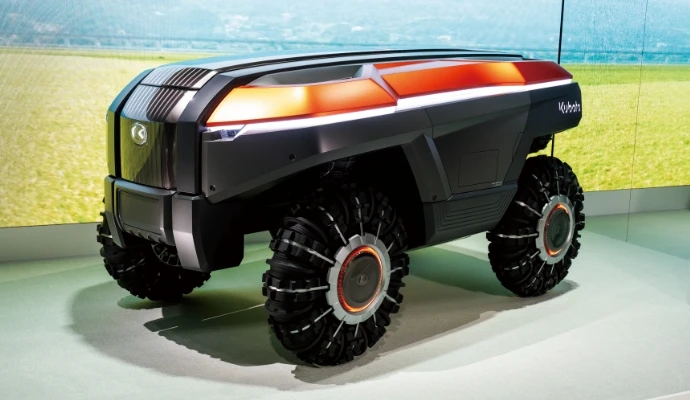
01 Fully Autonomous Operation
By analyzing a wide range of data and environmental inputs, Type: V can detect and carry out necessary tasks automatically. It acts almost like a partner, supporting farmers by offering actionable insights and tailored suggestions based on real-time data.
02 Transformable Body Structure
Type: V’s central chassis allows it to expand or contract laterally, vertically, and longitudinally. This enables the vehicle to adapt its width and height to suit the shape of furrows or the growth stage of crops. With attachments mounted to the sides, top, or underside, one machine can now perform tasks that previously required several different agricultural machines.
Type: S
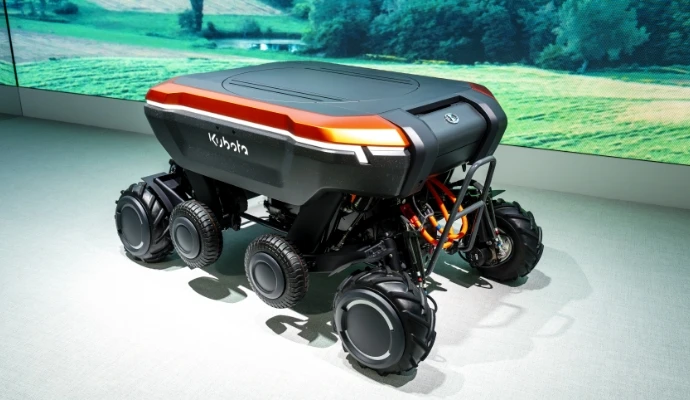
Type: S is designed specifically for hilly and uneven terrain, such as Japan’s many mountainous farming regions. It is built on an open-platform architecture, anticipating future integration with third-party modules and technologies.
In Japan, these regions account for roughly 40% of all farmland, agricultural output, and active farmers. Known as “satochi-satoyama”, these areas provide critical ecological functions such as flood mitigation, landslide prevention, and biodiversity preservation.

Despite their importance, mechanization in these regions has lagged due to their challenging landscapes. Manual labor still dominates. The introduction of Type: S marks a major leap forward, opening up a new frontier in mechanized agriculture.
Its four articulated legs allow it to grip uneven terrain, maintain horizontal stability, and maneuver efficiently over slopes and rough ground. This enables high-precision tasks such as spraying, data collection, and harvesting even in terraced rice fields or orchards where mechanization was once unthinkable.
Type: S is also compatible with a wide range of attachments—from robotic arms to sensors—and can integrate with equipment from other manufacturers thanks to its open design.
Kubota is not alone in this space. Agtech innovation is flourishing among startups both in Japan and around the world. Through co-creation with like-minded partners, Kubota aims to accelerate the development of planetary-conscious agriculture with greater speed and creativity.
Type: S’s foundational platform, KATR, has already earned global recognition, receiving the “Best of Innovation” award at CES Innovation Awards® 2025.
Building on this momentum, Kubota will continue driving forward to realize a brighter future for the Earth and all life it sustains.
A sustainable food system linked by data
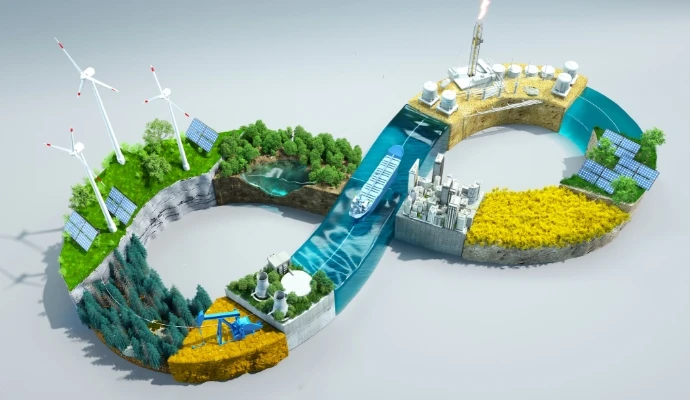
Green, unmanned, and intelligent agricultural machinery.
Moreover, Kubota has developed the Farm Management Information System (FMIS), a precision farming system that visualizes farm operations from multiple perspectives by integrating multiple data sources.
This precision agriculture system collects a wide range of data acquired by agricultural machinery equipped with ICT technology and uses this data to visualize crop information, improve work efficiency, optimize fertilizer application and water management, and improve the quality of agricultural produce.
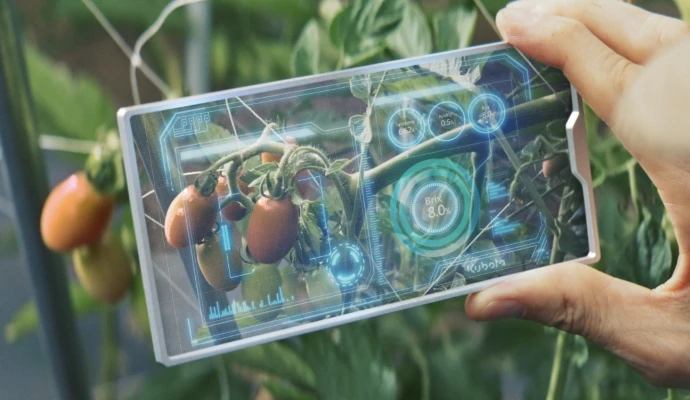
To further advance data-driven agriculture, we are also promoting the use of open platforms in precision agriculture systems so that these systems can be used in combination with external data when necessary.
Through these efforts, we are implementing detailed data-based management in agriculture, which is impacted by complex and varied environmental conditions, thereby allowing almost anyone to produce high-quality crops.
In addition, by providing a platform that makes it possible to manage the entire food value chain—from preparation, production, and processing to sales and consumption—by utilizing data, including selecting the most environmentally friendly transport methods for getting food from farmers to consumers, we will establish a sustainable food system that is friendly to both the Earth and to people.
Making effective use of agricultural resources
Growing and Harvesting Crops and Delivering Them to Consumers
It is very important to explore how this series of processes is
friendly to the Earth and to people.
Moreover, when we look at agriculture from a fresh perspective,
we realize that there are still many more ways in which agricultural resources
can be used to improve the Earth.
For instance, agricultural resources such as the by-products of harvesting and the power of the soil can be effectively utilized in ways other than for food production to produce positive effects on the global environment.
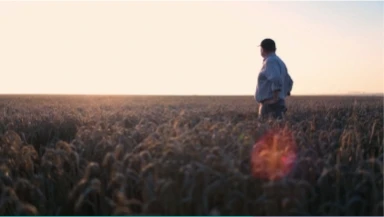
One example is Kubota’s methane fermentation technology, which is used to produce liquid fertilizer from rice straw as an alternative to chemical fertilizers that is non-polluting and gentle on the soil. Moreover, the biogas generated in the process of methane fermentation is converted into energy and returned to the local community, which also helps to reduce greenhouse gas emissions.
In addition, securing installation sites in order to expand the use of solar power generation, which does not emit CO2, is becoming increasingly challenging. To help address this situation, Kubota is promoting agrivoltaics—combined use of land for agriculture and solar power generation—that makes effective use of the space above growing crops to generate electricity while leaving sufficient space and light for crops.
Kubota will relentlessly pursue the possibilities of agriculture
to ensure that farming itself is beneficial to the Earth.
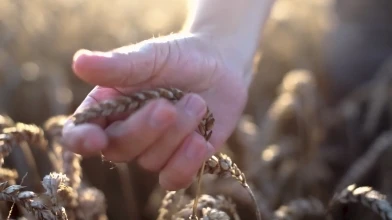
Making agriculture something for everyone

As farming becomes more labor-saving and more data-driven, farmers will be able to perform thousands, tens of thousands, or even more digital simulations of growing crops, whereas in the past they could only perform one new trial per year for each crop they grew, which adds up to at most a few dozen trials over the course of a lifetime.
From now on, when farmers want to do something, they will be able do it immediately.
And this will allow them to take on a wide variety of different challenges. Even new farmers and those with limited farming experience will be able to easily realize their dreams of what they want to produce and what they want to do with the help of “agricultural wisdom”.
As a result, in the future, agriculture will become easier and more accessible to everyone.

There are large-scale farmers who grow and supply food produce in substantial quantities on a consistent quality basis, small-scale farmers who grow and supply foods that combine high nutritional value and high added value to meet the demands of discriminating consumers, people who just want to grow their own food without calling themselves farmers, people who want to grow their own food and have a particular preference for organic or chemical-free methods, people who only want to engage in farming on weekends, and people who want to live in cities and farm remotely in the suburbs.
From now on, each individual will be able to choose the style of farming that best suits their own ideals.
At Kubota, we believe that as more people enjoy farming, more people will become spiritually enriched, and the happiness of society as a whole will increase.
Living with planetary-consciousness
Kubota is committed to being friendly to both the Earth and to people, driven by the aim of achieving a sustainable global environment and an affluent society.
Planetary-consciousness is both a way of thinking and a guideline for action.
Kubota is making a start by putting this philosophy into practice in the field of agriculture.
We are convinced that if industries everywhere promote planetary-conscious business, and if people everywhere live with a planetary-conscious mindset, then the Earth and all the living things that inhabit it will enjoy a future that continues to shine brightly.
